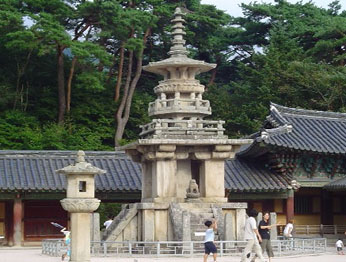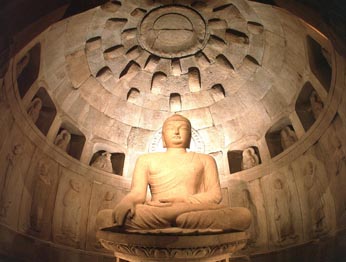GYEONGJU HISTORICAL AREAS

Sharp Travel & Tours Inc.
Contact Info
Telephone - 847.759.8813
Toll Free - 1.888.To.Sharp
Email - sharptour@hotmail.com

Gyeongju City and its surroundings have inherited traces of the glory that flowered and then withered in the ancient Silla Kingdom (57 B.C. - A.D.) 935. Both downtown and suburban areas contain many royal burial mounds and Buddhist remains, which preserve the arts and culture of the Silla Dynasty.
The Gyeongju Historic Areas where Mt. Namsan and many cultural properties are located contain a remarkable concentration of outstanding examples of Korean Buddhist art, in the form of sculptures, reliefs, pagodas, and the remains of temples and palaces, which were all built between the 7th and the 10th centuries.
Mt. Namsan Belt (Historic site No. 311)
Before the arrival of Buddhism in the early part of the Silla period, Mt. Namsan in Gyeongju City was worshiped as one of five sacred mountains. With the spread of Buddhism, it became the representation of Sumeru, the heavenly mountain of Land Buddhism.
Weolseong Belt
The ruins of Weolseong, the Half-Moon Palace, as well as numerous temples and fortress sites can all be seen here. In addition, Hwangnyongsa, the Temple of the Yellow Dragon, royal tombs, ancient wells and bridges can also be viewed here. The serene woods of Gyerim tell us the intriguing legends of the progenitor of the Gyeongju Kim clan, the family that reigned during most of the Silla kingdom. An ancient astronomical observatory called Cheomseongdae, which is one of the most exquisite examples of its type in Asia, is also located here.
Hwangnyongsa Belt
The temples of Hwangnyongsa and Bunhwangsa offer glimpses into the magnificence of Korea's ancient temples.
Sanseong (Fortress) Belt
Myeonghwal Mountain Fortress was built in the Fourth Century with advanced construction technologies that were later passed on to Japan.
Tumuli Park Belt
Splendid royal graves from the Silla Kingdom, and a range of excavated historical relics, including gold crowns and paintings, all display the essence of Silla culture.
Justification for Inscription:
Criterion ii The Kyongju Historic Areas contain a number of sites and monuments of exceptional significance in the development of Buddhist and secular architecture in Korea. Criterion iii The Korean peninsula was ruled for nearly a thousand years by the Shilla dynasty, and the sites and monuments in and around Kyongju (including the holy mountain of Namsan) bear outstanding testimony to its cultural achievements.

Please visit www.unesco.org for more information about UNESCO.
UNESCO Properties of Korea
© 2008 Sharp Travel and Tours Inc.